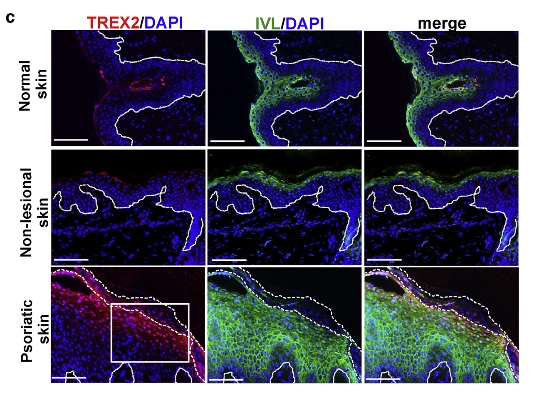Journal of Investigative Dermatology
has identified a potential therapeutic target for the treatment of psoriasis, a chronic inflammatory disease of the skin that affects up to a 2% of the population and which has still no cure. The study shows that the TREX2 gene has a relevant role in the inflammatory response that develops during the illness. The research, led by researchers from the Department of Pathology and Experimental Therapeutics of the
Faculty of Medicine and Health Sciences
of the University of Barcelona and the
Bellvitge Biomedical Research Institute (IDIBELL),
contributes to increase the knowledge about this complex and multi-factor inflammatory disease and opens doors to the development of new therapeutic strategies. The study also counts with the participation of experts from the Scientific and Technologic Centers of the UB
(CCiTUB), the Institute of Predictive and Personalized Medicine of Cancer (IMPPC), Hospital del Mar, and the Wake Forest University (North Carolina, USA). The
TREX2
gene codifies exonuclease that was related to the maintenance of genomic stability, and certain repairmen mechanisms such as DNA degradation. On previous studies, the research group saw that this protein made a presence specifically on the skin. Moreover, the study of deficient mice phenotype for this protein shows that the loss of
TREX2
creates a higher susceptibility to UV-induced skin carcinogenesis.
To go further in the TREX2
role in homeostasis and skin pathogenesis, the researchers wanted to see the role of this nuclease on psoriasis. At the beginning, they analyzed different biopsies of patients and people without the disease. Later, using different mice models of psoriasis, they compared the evolution of the disease on normal and deficient mice by
TREX2
to infer the function of this molecule. “The results show that
TREX2
would have a relevant role in the DNA degradation on psoriasis epidermis, provoking the characteristic inflammatory response of this disease”, says Concepció Soler, responsible of the study and professor at the Department of Pathology and Experimental Therapeutics of the University of Barcelona. The study shows that skin with psoriasis has a high increase of the
TREX2
expression that focuses on the cell nucleus of keratinocyte –the most abundant cells on the skin- which are spreading, dying and differentiating in a strange way. Therefore, the results suggest an important role of the processing DNA gene. “In our study, we highlight the essential role of
TREX2
promoting DNA degradation and its consequent cell death of keratinocyte, influencing the skin immune response. The release of several signals by skin cells that are dying contributes to the creation and spreading of the chronic immune response and hyper-proliferation and irregular differentiation of epidermis”, says Joan Manils, first author of the study and member of the mentioned department and post-doctorate researcher at the Trinity Biomedical Sciences Institute (Ireland). The results show
TREX2
as a potential therapeutic target to tackle this disease with a different and more focused strategy. “Most of the current treatments are aimed at blocking the action of the immune system and if they have good results, these treatments are chronic and involve the immune response of the sick person”, says Francisco Ciruela, co-author of the study, Professor at the Department of Pathology and Experimental Therapeutics of the UB and Head of the Research Group on Neuropharmacology and Pain at IDIBELL. The next objective of the researchers is to decode the action mechanism of
TREX2
in the development and maintenance of psoriasis, so as to design new therapeutic strategies for the treatment of this disease.

